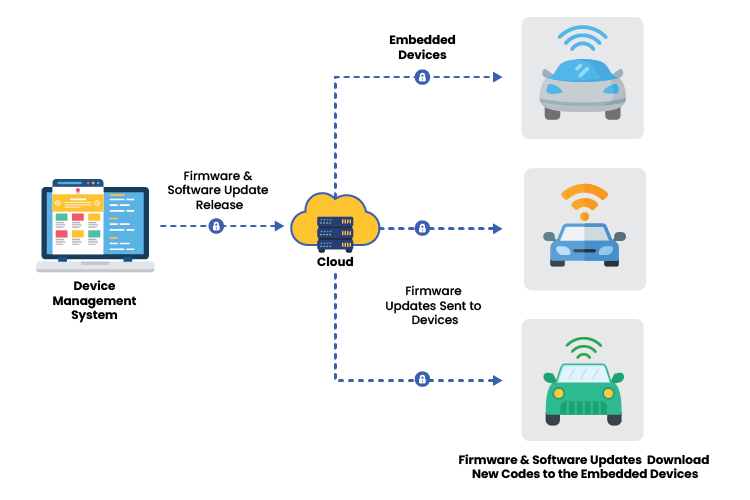
ACL Digital
Why Are OTA Updates Becoming Essential in the Automotive Industry?
The evolution of vehicles mirrors the changing times. Gone are the days when people spent weekends tweaking and maintaining their cars with manual tools. Today, digital management has revolutionized car maintenance, especially with electric vehicles (EVs). EVs eliminate the need for oil changes, and their coolants can outlast the vehicle itself. Tinkering with components like the battery pack is discouraged for safety and warranty reasons. Consequently, modern drivers may find themselves less involved in traditional upkeep tasks, thanks to this remarkable shift.
An over-the-air update (OTA) refers to a software download delivered remotely to your connected car, using either a SIM card with a data plan or a WiFi connection. Similar to how your iPhone updates overnight, OTA updates in vehicles are delivered directly from the manufacturer. These updates encompass system upgrades and fixes, addressing various components like powertrain systems, brakes, advanced driver assistance systems (ADAS), and even enhancements for electric vehicle (EV) charging and mileage. Let’s look into the workings, reasons to update and potential challenges of automotive security.
How Does an Over-the-Air (OTA) Update Work?
- An Over-the-Air (OTA) update is a process by which software updates are delivered and installed wirelessly to a device.OTA updates operate in various ways. However, from a fundamental viewpoint, the outline of the OTA process is as follows:
- The device manufacturer creates the update, fixing bugs, adding features, or enhancing functionalities, followed by continuous software testing and security checks for stability and security.
- The secure and tested update is then uploaded to a cloud server accessible by target devices.
- Devices periodically check for updates through built-in connections, with some allowing manual initiation.
- Upon detection, devices securely download updates from the cloud, with download times varying based on update size and internet speed.
- Devices undergo an installation process post-download, often involving system restarts, followed by verification to ensure proper installation and functionality.
- Successful installations prompt user notifications detailing the update’s completion and key features or bug fixes.
Why do cars need a software OTA update?
Frequent visits to the service center for updates can be cumbersome and costly. With OTA updates, your car can receive updates conveniently, without hassle, and directly at your location. Additionally, maintaining your car’s OTA updates will lessen the need for recalls and prevent your automobile from depreciating too much over time.
Neglecting essential updates for vehicles may leave it vulnerable to cyber-attacks and lead to decreased performance and efficiency. Simplifying the update process makes it more likely for drivers to stay proactive in maintaining their vehicles. Moreover, OTA updates accelerate bug resolution and address other issues without the need for vehicle recalls.
Advantages of Over-the-Air Updates
Over-the-Air (OTA) updates provide a convenient and efficient method to ensure devices maintain smooth and secure operations. Here are some key benefits:
Cost-effectiveness
Reduced administrative and logistical costs are achieved by eliminating expenses related to physical updates such as distribution and service calls. This streamlined process not only saves money but also ensures that devices receive timely updates, helping to maintain their performance and extend their lifespan.
Improved Functionality and Performance
Fixing bugs and improving device performance virtually eliminates the need for physical interaction with remote updates. Users can seamlessly unlock new features and functionalities without the hassle of upgrading hardware, while security updates are swiftly deployed to bolster protection against emerging threats. This streamlined approach ensures both user satisfaction and the continued security of the device.
Improved User Convenience
Remote updates eliminate the need for physical visits to service centers or manual installation, ensuring hassle-free maintenance. Scheduled updates can be set to occur during off-peak hours, optimizing device performance without disrupting usage. Additionally, users may have control over update scheduling, with options to pause or cancel updates as needed, offering flexibility and convenience.
Increased Safety
OTA updates promptly address vulnerabilities, bolstering overall device security against potential exploits. Furthermore, they enhance driver assistance systems by improving features such as automatic emergency braking and lane departure warning, ensuring safer and more reliable performance on the road.
Challenges with Over-the-Air (OTA) Update
- Addressing vulnerabilities during updates requires robust security measures due to potential vulnerabilities during downloading and installation.
- The risk of malicious interception or modification of updates underscores the need for strong authentication and encryption protocols.
- Navigating diverse regulatory standards across regions and countries while ensuring seamless OTA updates for vehicles poses a significant challenge for automakers.
- Limited internet access and data consumption concerns among users can impede updates, particularly in specific regions or demographics.
- Compatibility issues may arise, potentially causing malfunctions and conflicts with existing software.
- Implementing OTA updates demands significant infrastructure investment due to its technical complexity.
- Updates may disrupt user experience during installation or system restarts, and users may lack control over unwanted features or forced updates.
Over-the-Air (OTA) updates have indeed revolutionized the automotive industry, offering benefits that enhance the overall maintenance and user experience of vehicles. From bug fixes to performance improvements, and from unlocking new features to enhancing safety measures, the undeniable advantages of OTA updates signify a significant advancement in how we maintain and interact with our cars. As technology continues to evolve, OTA updates show a reflection to the ongoing innovation shaping the future of automotive engineering and user convenience.
Read more about our success stories and feel free to reach out to ACL Digital. Drop us a message at business@acldigital.com.
Related Insights

Best Practices for Authoring Test Cases in Software Testing

AI-Driven Quality Engineering: The Future of QA




